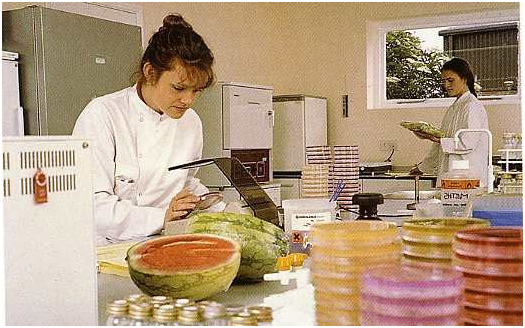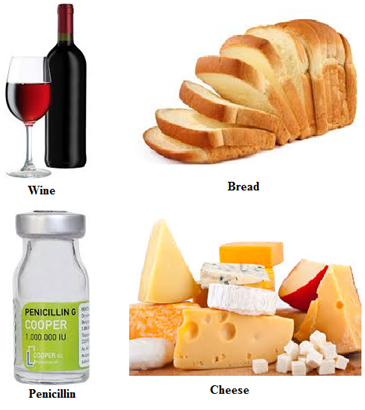Food microbiology is the branch of microbiology that deals with methods for keeping microorganisms (especially food-borne pathogens and spoilage microbes) from growing in food during handling, processing and storage. In food microbiology, microbes that are of importance in food production are studied by food microbiologists; and those pathogens that cause food borne diseases and food intoxifications or food poisoning in humans are covered under this broad topic known as food microbiology.
Food microbiology also encompasses food safety, food processing and handling, and food quality. It is noteworthy that different foods vary considerably in their sensitivity to microbial growth; and the growth of microbes in a particular food usually depends on the physical and chemical properties of the food since food vary in the pH, nutrient composition, moisture or water content and their consistency (i.e. whether the food is dry or moist).
The food we eat contains microorganisms at different state or different conditions. In most of the cases, these microorganisms (spoilage microbes or pathogenic microbes) may be introduced into the food from the environment through food handlers or during food preparation. The raw materials used for the food processing or production may also be a source of contaminating microbes in the food. Nevertheless, some specific microbes such as yeasts are purposely added to some food products including cheese, yoghurt, bread and sausage during their production because of the positive impact they create in such food products. These organisms that are purposely added to a food product during its production may help in improving the taste, texture, flavour and overall quality of the food product.
Once spoilage microbes gain entry into a given food, the organism will start to metabolize by using the food product as its source of energy and other growth nutrients. During this process, the organism produces waste products that change the taste and texture of the food, and this leads to the spoilage of the food product. Because of the reality of food spoilage, it is important to control microbial growth in foods so that the food will not serve as route for the transmission of disease-causing pathogens. Refrigeration, heating, irradiation and the use of chemical agents or preservatives are some of the techniques employed by microbiologists to contain microbial growth in food.
Food and food products are not only nutritive to the humans or animals that consume them, but they also serve as ideal culture environment for the growth of microorganisms including those that cause food borne diseases, food intoxications and food poisoning. And food products can also serve as an important route via which infectious diseases can be transmitted from person to persons and from one geographical area to another. Food microbiologists investigate by microbiological techniques the shelf life and microbiological quality of food and food products from food handling to food processing and even to the final consumer of the food in order to contain any outbreak of disease due to the consumption of contaminated food or food products.
Pasteurization, appertization, filtration and radiation techniques are some specific protocols carried in most food processing industries to produce food and food products that are safe for human and animal consumption. Food is any ingestible matter that living organisms metabolize or breakdown in vivo to generate energy and other precursors required for the biosynthesis of important macromolecules required for building the cell. Despite the importance of food to the body, it can also serve as an ideal environment for the growth and survival of pathogenic microorganisms inclusive of bacteria and fungi.
In general, food can also serve as ideal culture media for the growth of pathogens as aforementioned; and this is because they contain nutritive factors that support the growth of microbes. The contamination of food by microbes can cause food poisoning, food intoxication and food spoilage; and this phenomenon renders the food unfit for consumption. The quality of food can be affected from the point of handling to processing if proper aseptic measures are not observed during processing, and this could affect the health of the host taking it.
The microbial contamination of food and food products can come from the air, soil, water, plants, animals, food handlers and the equipment used in food processing. Though food cannot be completely sterile as it could be contaminated at one point or the other during handling and processing; it is critical to ensure proper storage and processing of food so as to reduce their microbial load and avert possible microbial infection through their consumption.
Aeromonas, Brucella, pathogenic strains of Escherichia coli, Bacillus, Campylobacter, Clostridium, Listeria, Salmonella, Shigella, Staphylococcus, Yersinia and Vibrio are some bacterial genera that are implicated in causing various forms of diseases or infections associated with the consumption of contaminated food. Food can serve as medium via which these pathogens are transmitted and thus it is vital to ensure that food is properly handled and processed in order to contain food-borne diseases in human population.
References
Bushell M.E (1998). Application of the principles of industrial microbiology to biotechnology (ed. Wiseman, A.) Chapman and Hall, New York.
Byong H. Lee (2015). Fundamentals of Food Biotechnology. Second edition. Wiley-Blackwell, New Jersey, United States.
Clark D.P and Pazdernik N (2010). Biotechnology. First edition. Elsevier Science and Technology Books, Amsterdam, Netherlands.
Farida A.A (2012). Dairy Microbiology. First edition. Random Publications. New Delhi, India.
Frazier W.C, Westhoff D.C and Vanitha N.M (2014). Food Microbiology. Fifth edition. McGraw-Hill Education (India) Private Limited, New Delhi, India.
Guidebook for the preparation of HACCP plans (1999). Washington, DC, United States Department of Agriculture Food Safety and Inspection Service. Accessed on 20th February, 2015 from: http://www.fsis.usda.gov
Hayes P.R, Forsythe S.J (1999). Food Hygiene, Microbiology and HACCP. 3rd edition. Elsevier Science, London.
Hussaini Anthony Makun (2013). Mycotoxin and food safety in developing countries. InTech Publishers, Rijeka, Croatia. Pp. 77-100.
Jay J.M (2005). Modern Food Microbiology. Fourth edition. Chapman and Hall Inc, New York, USA.
Lightfoot N.F and Maier E.A (1998). Microbiological Analysis of Food and Water. Guidelines for Quality Assurance. Elsevier, Amsterdam.
Nduka Okafor (2007). Modern industrial microbiology and biotechnology. First edition. Science Publishers, New Hampshire, USA.
Roberts D and Greenwood M (2003). Practical Food Microbiology. Third edition. Blackwell publishing Inc, USA.
Discover more from #1 Microbiology Resource Hub
Subscribe to get the latest posts to your email.



